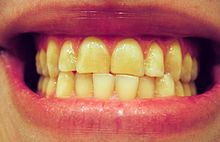Parafunction
The chewing organ is also involved in swallowing, in addition to chopping up food and forming speech. Parafunctions (sometimes also oral habit ) is a collective term for a non-natural use of the chewing organ.
Which includes:
- Clenching your teeth and grinding your teeth (bruxism)
- Lip and cheek biting
- Thumb sucking
- Pencil and fingernail chewing .
This behavior essentially takes place unconsciously. It is usually acquired in childhood and is part of a person's personality profile . The parafunction takes place more intensely under emotional tension . Parafunctions are essentially an indicator of the patient's internal state. The behavioral therapy provides concepts to this behavior when it is bothersome or takes pathological forms wean.

consequences
Parafunction is also one of the symptoms of a TMJ disease. The parafunction can be both a cause and a consequence of this.
Parafunctions can cause damage to the dentition through abrasion of the teeth , such as tooth cracks, tooth chipping, breaking of tooth edges. The hard tooth substance ( tooth enamel ) and later also the dentine underneath is removed by the constant rubbing against each other during grinding and pressing . Parafunctions can contribute to the development of periodontitis and, in the case of other aggravating factors, lead to tooth loss. Temporomandibular joint complaints, neck muscles, shoulder muscles or headaches can also result. Thumb sucking is also believed to cause misaligned teeth in children over the age of three .
trigger
Mainly the grinding of teeth can be influenced by triggering or entertaining factors, such as B .:
- Early contact of the teeth
- protruding fillings or
- Difficulty with dentures
- Hypersensitive tooth necks
- centrally induced muscular hyperactivity ( hypervigilance )
- hormonal disorders
- emotional stress
- Tinnitus
Definition of the scientific society
The German Society for Dentistry, Oral and Maxillofacial Medicine (DGZMK) defines bruxism as parafunction, furthermore ( grinding , clenching), tongue clenching and lip biting with non-physiological effects on teeth , periodontia , the masticatory muscles and / or the temporomandibular joints .
See also
Individual evidence
- ↑ Gundula Johnke, Psychic aspects of dental parafunctions , Schlütersche Verlag, 2000, ISBN 3-87706-564-3
- ↑ DGZMK, patient information on oral parafunctions
